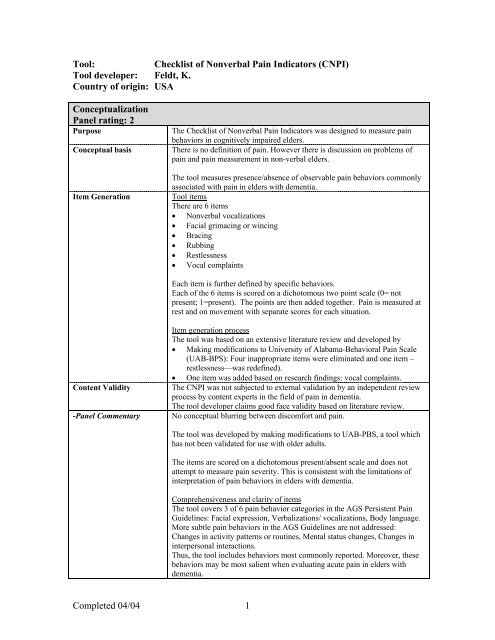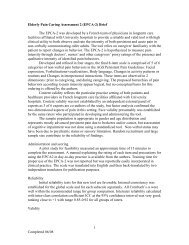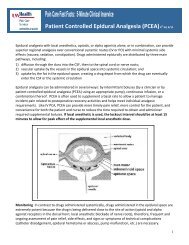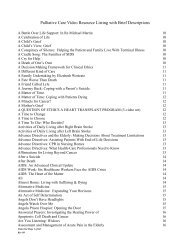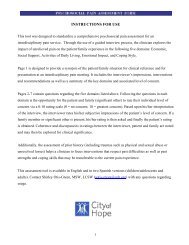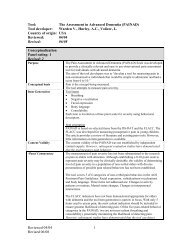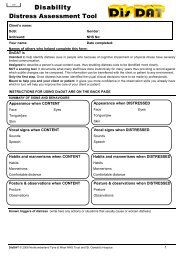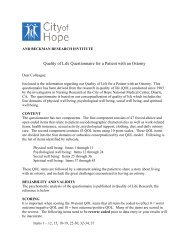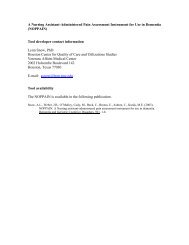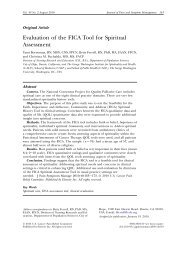Checklist of Nonverbal Pain Indicators (CNPI)
Checklist of Nonverbal Pain Indicators (CNPI)
Checklist of Nonverbal Pain Indicators (CNPI)
- No tags were found...
You also want an ePaper? Increase the reach of your titles
YUMPU automatically turns print PDFs into web optimized ePapers that Google loves.
Tool:<strong>Checklist</strong> <strong>of</strong> <strong>Nonverbal</strong> <strong>Pain</strong> <strong>Indicators</strong> (<strong>CNPI</strong>)Tool developer: Feldt, K.Country <strong>of</strong> origin: USAConceptualizationPanel rating: 2PurposeConceptual basisItem GenerationThe <strong>Checklist</strong> <strong>of</strong> <strong>Nonverbal</strong> <strong>Pain</strong> <strong>Indicators</strong> was designed to measure painbehaviors in cognitively impaired elders.There is no definition <strong>of</strong> pain. However there is discussion on problems <strong>of</strong>pain and pain measurement in non-verbal elders.The tool measures presence/absence <strong>of</strong> observable pain behaviors commonlyassociated with pain in elders with dementia.Tool itemsThere are 6 items• <strong>Nonverbal</strong> vocalizations• Facial grimacing or wincing• Bracing• Rubbing• Restlessness• Vocal complaintsEach item is further defined by specific behaviors.Each <strong>of</strong> the 6 items is scored on a dichotomous two point scale (0= notpresent; 1=present). The points are then added together. <strong>Pain</strong> is measured atrest and on movement with separate scores for each situation.Content Validity-Panel CommentaryItem generation processThe tool was based on an extensive literature review and developed by• Making modifications to University <strong>of</strong> Alabama-Behavioral <strong>Pain</strong> Scale(UAB-BPS): Four inappropriate items were eliminated and one item –restlessness—was redefined).• One item was added based on research findings: vocal complaints.The <strong>CNPI</strong> was not subjected to external validation by an independent reviewprocess by content experts in the field <strong>of</strong> pain in dementia.The tool developer claims good face validity based on literature review.No conceptual blurring between discomfort and pain.The tool was developed by making modifications to UAB-PBS, a tool whichhas not been validated for use with older adults.The items are scored on a dichotomous present/absent scale and does notattempt to measure pain severity. This is consistent with the limitations <strong>of</strong>interpretation <strong>of</strong> pain behaviors in elders with dementia.Comprehensiveness and clarity <strong>of</strong> itemsThe tool covers 3 <strong>of</strong> 6 pain behavior categories in the AGS Persistent <strong>Pain</strong>Guidelines: Facial expression, Verbalizations/ vocalizations, Body language.More subtle pain behaviors in the AGS Guidelines are not addressed:Changes in activity patterns or routines, Mental status changes, Changes ininterpersonal interactions.Thus, the tool includes behaviors most commonly reported. Moreover, thesebehaviors may be most salient when evaluating acute pain in elders withdementia.Completed 04/04 1
SubjectsPanel rating: 1Subjects-Panel CommentaryAlthough content validity was not evaluated through an external review bycontent experts, the <strong>CNPI</strong> does appear to have face validity for assessment <strong>of</strong>pain in elders with dementia.The tool was tested in a convenience sample <strong>of</strong> 88 cognitively impaired andcognitively intact subjects undergoing surgery for hip fracture.Average age: 83.2 (±7.7) Range: 65-101.Gender: Female: 86%, Male: 14%.MMSE was used to assess for cognitive status with a cut<strong>of</strong>f for cognitiveimpairment at ≤ 23.Average MMSE for total sample =18.1Fifty-three patients had MMSE ≤ 23. Average MMSE: 12.2 (±8.0).Thirty-five patients had MMSE > 23. Average MMSE: 27.2 (±1.9).Acute care hospital setting is clearly identified as the care setting.No testing in long term care is currently available.The cognitively impaired patients have been identified as having dementiausing the MMSE, which is an appropriate instrument for screening fordementia. The cognitively impaired elders in this study have a low level <strong>of</strong>cognitive function on the MMSE. However, acute confusion was notmeasured and is also <strong>of</strong>ten present in hospitalized elders with hip fracture.Age <strong>of</strong> the subjects is appropriate.The sample is predominantly women.There is no information on ethnic/racial diversity.Using 5 subjects per tool item as a rule <strong>of</strong> thumb, a minimum sample size <strong>of</strong>30 subjects (6 items x 5 subjects) would be needed. Thus, this sample <strong>of</strong> 88subjects is sufficient for tool evaluation.Administration, Scoring, FeasibilityPanel rating: 2Administration,Scoring,Feasibility-Panel CommentaryThere are 6 items, each <strong>of</strong> which is further defined by specific behaviors.Each item is scored on a dichotomous two point scale (0= not present ;1=present). The points are then added together.<strong>Pain</strong> is measured at rest and on movement with separate scores for eachsituation.Method <strong>of</strong> administration is clear.Scoring procedures are clearly described and simple to follow.No interpretation <strong>of</strong> tool score is provided.Clinical utility• Time: The time needed to administer the tool has not been formallyevaluated. However, the tool is short and appears easy to use.• Skill needed: Skill level needed to use the tool reliably is not addressed.In the initial study, two gerontological nurse practitioners didassessments. However, it is not known how the tool performs whenadministered by staff nurses.Completed 04/04 2
ReliabilityPanel rating: 2Internal consistencyObservations <strong>of</strong> the subjects were conducted at approximately the thirdpostoperative day. Observations were made <strong>of</strong> subjects at rest and withmovement (sample specifications are provided above).Raters were gerontological nurse practitioners with Master’s degrees.Interrater reliabilityResults:KR-20 (=alpha for dichotomous variables).At rest: .54 (95% CI=.38 -.68)With movement: .54 (95% CI=.49-.75)Interrater reliability was established in a subgroup <strong>of</strong> 12 patients from thestudy sample.Raters were gerontological nurse practitioners with Master’s degrees.Observations were conducted1) at rest (while the subject was lying in bed)2) on movement (during transfer bed to chair).Test-retest reliability-Panel commentaryResults:93% agreement on dichotomous checklist itemsKappa=0.63-0.82 for behaviors observed.No test-retest reliability or intrarater reliability is available.Internal consistencyRaters are qualified.Method <strong>of</strong> testing internal consistency is appropriate for the data.Correlation coefficients are low, which may relate to the few items in the tool,however further evaluation is recommended.Interrater reliabilityRaters are qualified.% agreement and kappa statistic are appropriate for the data.Results are good. However, not all behaviors on the tool were observed.Moreover, the results <strong>of</strong> only one study with a small sample size have beenreported.Test-retest reliabilityTest-retest reliability is not an appropriate parameter to examine whenassessing acute pain due to its changing nature. However, test-retestreliability should be established when used with persistent pain states.Validity: Criterion or constructPanel rating: 1Construct validity/Criterion related validityConcurrent criterion related validity<strong>CNPI</strong> scores compared with VDS scores (VDS scores transcribed intonumbers 0=no pain, 1=slight pain, 6=pain as bad as it could be.) 64 patientshad <strong>CNPI</strong> and VDS scores.At rest With movement<strong>Pain</strong> in total population r s =.37, p=.001* r s =.43, p
<strong>Pain</strong> at rest correlated weakly within the impaired group. According to thetool developer the tool is only valid for assessment <strong>of</strong> pain with movementConstruct validityThe data above demonstrate construct validity <strong>of</strong> the <strong>CNPI</strong> because higherscores were attained during periods <strong>of</strong> movement eliciting discomfort thanduring periods <strong>of</strong> rest.-Panel commentary Use <strong>of</strong> VDS with cognitively impaired individuals as a gold standard may beproblematic and contribute to lower correlation.Although the validity data is in the expected direction, testing with a morecognitively impaired sample is needed to assess tool sensitivity to detect pain.Summary <strong>of</strong> panel evaluation <strong>of</strong> pain assessment toolThe <strong>CNPI</strong> is a brief, clinically useful approach to assessing pain in elders with cognitive impairment. Itemsincluded in the scale are conceptually sound. Preliminary tool testing provides initial support for use <strong>of</strong> thetool at least with elders in acute care setting.The <strong>CNPI</strong> needs further evaluation to determine its usefulness with nonverbal elders including those in longterm care settings. Addition <strong>of</strong> items that consider more subtle behaviors or changes in behaviors orinteraction would improve comprehensiveness and ability to detect pain in those with less obviousbehavioral manifestations. Additionally, tool testing with males and minority samples is needed. Additionalevidence <strong>of</strong> reliability is needed, as well, particularly with use by staff nurses rather than trained geriatricnurse practitioners.Sources <strong>of</strong> evidenceFeldt, K. S. (1996). Treatment <strong>of</strong> pain in cognitively impaired versus cognitively intact post hipfractured elders. (Doctoral dissertation, University <strong>of</strong> Minnesota, 1996). Dissertation AbstractsInternational, 57-09B, 5574.Feldt, K. S. (2000). The <strong>Checklist</strong> <strong>of</strong> <strong>Nonverbal</strong> <strong>Pain</strong> <strong>Indicators</strong> (<strong>CNPI</strong>). <strong>Pain</strong> Management Nursing, 1(1),13-21.Feldt, K. S. (2000). Improving assessment and treatment <strong>of</strong> pain in cognitively impaired nursing homeresidents. Annals <strong>of</strong> Long Term Care, 8(9), 36-42.Key to panel rating3= Available evidence is strong2= Available evidence supports need for further testing1= Available evidence is insufficient and/or tool revisions are needed0= Evidence is absentEvaluation completed by:K. Herr, S. Decker, K. Bjoro, University <strong>of</strong> Iowa.Contact information: keela-herr@uiowa.eduCompleted 04/04 4


